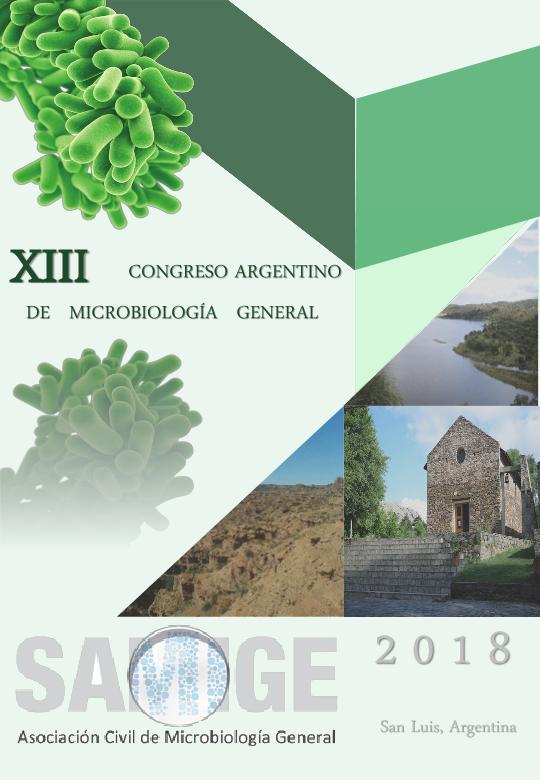Mostrar el registro sencillo del ítem
dc.contributor.author
Galera, Ivana Laura Delia

dc.contributor.author
Quinteros, Melisa de Los Ángeles

dc.contributor.author
Páez, Paulina Laura

dc.contributor.author
Paraje, María Gabriela

dc.date.available
2022-08-30T18:18:51Z
dc.date.issued
2018
dc.identifier.citation
Candida albicans planktonic and sessile cells treated with biosynthesized silver nanoparticles; XIII Congreso Argentino de Microbiología General; San Luis; Argentina; 2018; 28-28
dc.identifier.uri
http://hdl.handle.net/11336/166983
dc.description.abstract
Candida albicans is anormal commensal of the gastrointestinal microbiota in healthy individuals; however, as an opportunistic pathogen, is the most common etiological agent of candidiasis. C.albicans has the ability to form biofilms and morphogenetic conversions between yeast and hyphal morphologies contribute to biofilm development and representan essential virulence factor. These attached communities of cells are surrounded by a protective exopolymeric matrix that effectively shelters Candida against the action of antifungals (ATFs). As fungi are eukaryotic, esearch and development of new ATFs agents have been difficult due to the limited number of selective targets, also leading to toxicity. Silver nanoparticles (AgNPs) were considered, in recent years, particularly attractive for the production ofa new class of antimicrobials and the use of microorganisms for the synthesis of nanoparticles is relatively new in basic research and technology areas, opening up a completely new way to combat a wide range of pathogens. Although the highly antibacterial effect of AgNPs has been described, their mechanism ofaction is yet to be fully elucidated. This study firstly evaluated the activity of biosynthesized AgNPs in Candida albicans planktonic cells and then the effect over biofilms.TheAgNPs was synthesized by the supernatant of Pseudomonas aeruginosa and characterized by Ultraviolet-visible (UV-vis)spectroscopy, dynamic light scattering (DLS) and transmission electronmicroscopy (TEM), previously by Quinteroset al, 2016. Minimum inhibitory (MIC), minimum fungicidal concentrations for planktoniccells (MFC) and minimum biofilm inhibitory concentration (MBIC) ofthe AgNPs and amphotericin B (AmB)against C. albicans were determined byplate microdilution technique at sub y supra CIM concentration. Biofilmformation (48 h of incubation) was assayed by adhesion to 96-well plate andcrystal violet (CV) stain (0.1 OD595nm=1BBU). Viable cells were determined by enumeration colony-forming units per milliliter (CFU/mL) and the results showed a good correlation with the CV assay. Ourresults demonstrate that AgNPs are potent inhibitors of C. albicans planktonic cells. The MIC results showed that AgNPs were fungicidal against C.albinans SC5314 (0.037 pM) and C. albinans L20 (0.15 pM) at very low concentrations compared to silver standard (AgNO3 4 x 107 pMand 2 x 107 pM respectively) and AmB (2.7 x 105 pM). Biofilm reduction of both strains was obtained, however, sessile cells are not fully removed. These results are promising for its future application,due to the high activity observed at low concentrations. The bio synthesized AgNPs solution is a promising ATFs agents, these approaches are expected to be helpful in finding new molecules to help resistance to ATFs. Nanoparticles are now considered a viable alternative and seem to have a high potential to solve the problem of the emergence of bacterial multidrug resistance.
dc.format
text/plain
dc.language.iso
eng
dc.publisher
Asociación Civil de Microbiología General
dc.rights
info:eu-repo/semantics/openAccess
dc.rights.uri
https://creativecommons.org/licenses/by-nc-sa/2.5/ar/
dc.subject
Candida
dc.subject
Biosynthesized
dc.subject
Nanoparticles
dc.subject
Micology
dc.subject.classification
Biología Celular, Microbiología

dc.subject.classification
Ciencias Biológicas

dc.subject.classification
CIENCIAS NATURALES Y EXACTAS

dc.title
Candida albicans planktonic and sessile cells treated with biosynthesized silver nanoparticles
dc.type
info:eu-repo/semantics/publishedVersion
dc.type
info:eu-repo/semantics/conferenceObject
dc.type
info:ar-repo/semantics/documento de conferencia
dc.date.updated
2022-08-24T19:18:47Z
dc.journal.pagination
28-28
dc.journal.pais
Argentina

dc.journal.ciudad
San Luis
dc.description.fil
Fil: Galera, Ivana Laura Delia. Consejo Nacional de Investigaciones Científicas y Técnicas. Centro Científico Tecnológico Conicet - Córdoba. Instituto Multidisciplinario de Biología Vegetal. Universidad Nacional de Córdoba. Facultad de Ciencias Exactas Físicas y Naturales. Instituto Multidisciplinario de Biología Vegetal; Argentina. Universidad Nacional de Córdoba. Facultad de Ciencias Exactas Físicas y Naturales. Departamento de Fisiología; Argentina
dc.description.fil
Fil: Quinteros, Melisa de Los Ángeles. Consejo Nacional de Investigaciones Científicas y Técnicas. Centro Científico Tecnológico Conicet - Córdoba. Instituto Multidisciplinario de Biología Vegetal. Universidad Nacional de Córdoba. Facultad de Ciencias Exactas Físicas y Naturales. Instituto Multidisciplinario de Biología Vegetal; Argentina. Universidad Nacional de Córdoba. Facultad de Ciencias Químicas. Departamento de Farmacia; Argentina
dc.description.fil
Fil: Páez, Paulina Laura. Consejo Nacional de Investigaciones Científicas y Técnicas. Centro Científico Tecnológico Conicet - Córdoba. Unidad de Investigación y Desarrollo en Tecnología Farmacéutica. Universidad Nacional de Córdoba. Facultad de Ciencias Químicas. Unidad de Investigación y Desarrollo en Tecnología Farmacéutica; Argentina. Universidad Nacional de Córdoba. Facultad de Ciencias Químicas. Departamento de Farmacia; Argentina
dc.description.fil
Fil: Paraje, María Gabriela. Consejo Nacional de Investigaciones Científicas y Técnicas. Centro Científico Tecnológico Conicet - Córdoba. Instituto Multidisciplinario de Biología Vegetal. Universidad Nacional de Córdoba. Facultad de Ciencias Exactas Físicas y Naturales. Instituto Multidisciplinario de Biología Vegetal; Argentina. Universidad Nacional de Córdoba. Facultad de Ciencias Exactas Físicas y Naturales. Departamento de Fisiología; Argentina
dc.relation.alternativeid
info:eu-repo/semantics/altIdentifier/url/http://www.samige.org.ar/admin/news/files/123-Libro%20samige%202018%20v3.pdf
dc.conicet.rol
Autor

dc.conicet.rol
Autor

dc.conicet.rol
Autor

dc.conicet.rol
Autor

dc.coverage
Nacional
dc.type.subtype
Conferencia
dc.description.nombreEvento
XIII Congreso Argentino de Microbiología General
dc.date.evento
2018-08-08
dc.description.ciudadEvento
San Luis
dc.description.paisEvento
Argentina

dc.type.publicacion
Book
dc.description.institucionOrganizadora
Asociación Civil de Microbiología General
dc.source.libro
XIII Congreso Argentino de Microbiología General
dc.date.eventoHasta
2018-08-10
dc.type
Conferencia
Archivos asociados
